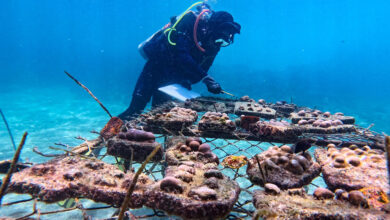Panama’s Guna People Relocate to Mainland, Strive to Save Culture

The Guna people of Gardi Sugdub, Panama, are relocating due to rising sea levels caused by climate change, marking them as the country’s first climate change refugees. Their move to the mainland underscores the challenges of preserving cultural heritage amid environmental upheaval.
A padlock hangs on the doors of the homes in Gardi Sugdub, a Caribbean island of Panama, signaling a departure many hoped would never come. The indigenous Guna people, who have called this island home for over a century, are packing their belongings as rising seas and overcrowding force them to leave. This week, the Guna people became Panama’s first climate change refugees, an unsettling sign of the growing impact of global warming on vulnerable communities.
The Guna Yala archipelago, comprising 365 small islands, has long been a sanctuary for the Guna people. However, the increasing sea levels, predicted by the Panamanian government to rise by 0.27 meters by 2050 in an optimistic scenario, are rendering these islands uninhabitable. With the islands barely above sea level, even minor increases are catastrophic.
Faced with these dire circumstances, the Guna community of Gardi Sugdub is moving to a newly constructed neighborhood on the mainland called Isberyala (the land of the loquats). This $12.2 million project, funded by the Panamanian government, has faced delays but finally opened its doors last week. The official relocation began on Monday, marking the end of an era for the island’s residents.
A New Beginning
Gardi Sugdub has been bustling with activity for three days as boats ferry people and their belongings to the mainland. The Guna carry bags filled with clothes, food, and even mattresses with the help of Panamanian authorities. However, amid the chaos of moving, a common concern echoes among the people: “How will we live there?”
Herculano Lombarto, a 63-year-old resident, embodies this uncertainty. He plans to split his time between the island and the mainland. Lombarto runs a business on the island, supplying food and drink to boats transporting tourists. “Here, the island is economically active because of tourism. Businesses do well. Over there, it’s new and not economically viable yet. More businesses will emerge with time,” he explains from his chair facing the sea. Lombarto also plans to build a traditional Guna house with palm leaves next to his new prefabricated home.
The transition from the sea to the mainland is drastic. The Guna people are moving from homes with limited basic services to ones with running water and electricity. While this upgrade offers new opportunities, it also challenges preserving their ancestral customs.
“Culture is ours. It comes from within us. We pass it down from generation to generation,” says 90-year-old Melania Morris, dressed in the colorful mola, the traditional attire of Guna women. Morris is determined to maintain their cultural practices and traditional cuisine despite the move. The new Isberyala neighborhood spans 14 hectares and includes 300 homes, each with two bedrooms, a living-dining area, a bathroom, and a laundry room, designed to house over 1,350 people.
The community also features a traditional ‘casa quincha’ for local congress meetings to preserve their customs. However, unlike on the island, the absence of a health center raises concerns among residents, especially those caring for older people. Additionally, a school of about 650 students offers a modern educational environment compared to the overcrowded and dilapidated school on the island.
Dalis Morris, Melania’s daughter and a teacher on the island, is excited about the new school but worried about teaching children how to cross streets safely. To address this, they organized a crossing drill during the relocation. “The students themselves want to move. They’ve been waiting for years. There are spaces to play over there. But these children were born here. In their innocence, they don’t look when crossing the street,” she explains.
Overcrowding has hastened the exodus from Gardi Sugdub. Families live in cramped conditions in makeshift wooden homes with zinc roofs. The island’s labyrinthine streets and widespread waste add to the dire living conditions. Inhabitants acknowledge that flooding has been a problem since “ancestral times,” but overpopulation has exacerbated the situation. “The tide rises and falls as it always has. But now, it’s starting to flood more gradually and will take years. The houses flood when high tides coincide with rains,” notes Lombarto.
The Guna community of Gardi Sugdub initially planned to move to the mainland before the government formalized it. “We Guna comes from the land, not the sea. Here, we were displaced. Now we return to our origins,” Lombarto asserts.
Climate Change and Indigenous Displacement
The Guna people’s relocation is not just their story, but part of a broader narrative of climate-induced displacement affecting indigenous communities worldwide. Their experience underscores the urgent need for global action on climate change, as rising sea levels, more frequent and severe weather events, and changing ecosystems force many communities to leave their ancestral lands.
In Latin America, indigenous communities have faced various challenges, including land dispossession, cultural erosion, and economic marginalization. The Guna’s situation highlights the additional burden of climate change, exacerbating existing vulnerabilities and creating new threats.
The Panamanian government’s involvement in building the Isberyala neighborhood significantly addresses climate-induced displacement. However, the project’s delays reflect broader issues in disaster preparedness and response. Effective relocation requires physical infrastructure and support for cultural preservation, economic integration, and social services.
International support and cooperation are not just beneficial, but crucial in mitigating climate change’s impacts on vulnerable communities. The Guna people’s situation underscores the need for global initiatives to reduce carbon emissions, provide financial assistance for adaptation, and recognize the rights of indigenous peoples. It’s a shared responsibility to ensure a comprehensive response to climate change.
The Future of Gardi Sugdub
The relocation to Isberyala signifies a new era for the Guna people of Gardi Sugdub. Despite the challenges, this transition also presents opportunities for enhancing living conditions and safeguarding cultural heritage. The Guna community’s resilience and adaptability stand as a testament to their strength, inspiring us with their ability to navigate change.
For residents like Herculano Lombarto, the move is a return to their roots. “The Guna comes from the land,” he emphasizes, looking forward to reconnecting with their ancestral origins. As they settle into their new homes, the Guna people will continue to draw strength from their rich cultural traditions and communal bonds.
Preserving Cultural Heritage
Preserving the Guna culture is paramount amid the physical relocation. The new community of Isberyala has been designed with cultural preservation in mind, including spaces for traditional practices and gatherings. The challenge will be maintaining these traditions in a new environment. Efforts are being made to ensure that Guna’s customs, language, and lifestyle continue to thrive.
Melania Morris’s determination to keep their traditional cuisine alive and teach the next generation about their heritage is a beacon of hope. The presence of a conventional congress house (casa quincha) in Isberyala aims to facilitate the continuation of Guna governance and cultural practices. The community’s efforts to integrate their traditional lifestyle into the new setting will be crucial for their cultural survival.
Establishing a modern school in Isberyala offers the younger generation better educational opportunities. However, it also introduces new challenges, such as adapting to a different lifestyle and learning environment. Teachers like Dalis Morris play a critical role in bridging the gap between old and new, ensuring that children retain their cultural identity while benefiting from improved educational infrastructure.
The Guna community’s focus on education reflects a broader trend in Indigenous communities across Latin America, where education is critical to preserving cultural heritage and advancing socio-economic opportunities. The new school in Isberyala is more than a building; it symbolizes hope for the future, blending tradition with modernity.
International Perspective
The plight of the Guna people resonates with Indigenous communities worldwide facing similar threats from climate change. Their story highlights the need for comprehensive strategies addressing environmental and cultural impacts. As global temperatures rise and sea levels increase, the international community must recognize and act on indigenous populations’ unique vulnerabilities.
The Guna’s relocation is a microcosm of the more significant climate crisis, emphasizing the importance of sustainable solutions prioritizing human rights and cultural preservation. It calls for international solidarity and action to support indigenous communities in adapting to climate change while maintaining their cultural identities.
The Guna people’s move to Isberyala is not just a physical relocation but a journey of cultural preservation and adaptation. Their resilience and commitment to their heritage will be tested as they navigate this transition. The success of this relocation depends on the community’s ability to integrate their traditions into their new environment and the support they receive from the government and international bodies.
Also read: The Guna’s Struggle Against Climate Change in Panama
The story of the Guna people is a powerful reminder of the human dimension of climate change. It underscores the need for policies and actions that respect and uphold the rights of indigenous communities. As the world grapples with climate change’s impacts, the Guna people’s experiences offer valuable lessons in resilience, adaptation, and cultural preservation.
Their journey is a testament to the strength of Indigenous communities and a call to action for a more inclusive and sustainable future.



